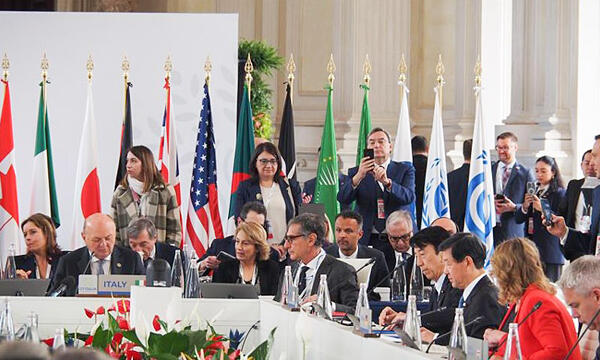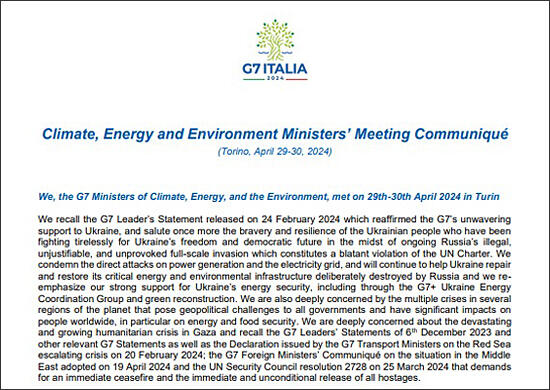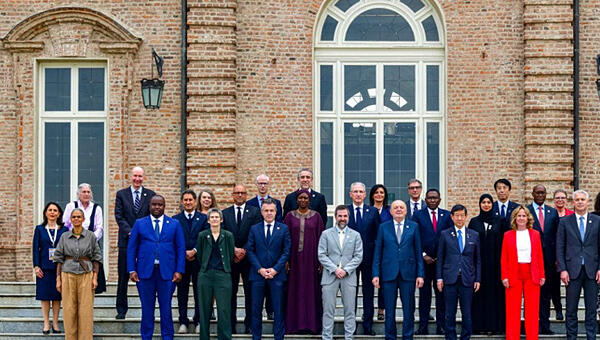In the joint statement issued following the meeting of climate, energy and environment ministers of the Group of Seven (G7) industrialized nations in Turin, Italy, on April 29 and 30, the group agreed to phase out coal-fired power generation without carbon dioxide (CO2) emission reduction measures by 2035, among other measures. This is in line with the agreement reached at the 28th Conference of the Parties (COP28) to the United Nations Framework Convention on Climate Change held in the United Arab Emirates from the end of November to December last year to "move away from fossil fuels" and "triple the use of renewable energy." It was the first time that a G7 Joint Statement included the time frame for abolishment of coal-fired power plants that emit large amounts of CO2.
Japan's power is highly dependent on thermal power generation, which currently accounts for approximately 70% of its generation, and coal-fired power generation accounts for approximately 30%. Its current Strategic Energy Plan still projects approximately 20% as of FY30. On the 15th, discussions on the revision of the next plan began at a subcommittee of the Advisory Committee for Natural Resources and Energy. The agreement reached at the G7 environment ministers' meeting, and the content of the joint statement will inevitably affect Japan's energy policy, including discussions on its next plan.

Provided by METI
Responsibility to implement the contents of the COP28 agreement
The joint statement agreed to at the G7 Environment Ministers' Meeting and declared to the international community as the G7 is 35 pages long with 45 items. It sets out policies and directions for global environmental and energy issues broadly centered on climate change issues and confirms that the G7 will carry out the agreements reached at COP28 as its responsibilities.
The joint statement first touched on the current difficult international situation, noting that the G7 "salutes once more the bravery and resilience of the Ukrainian people who have been fighting tirelessly for Ukraine's freedom and democratic future" and "is deeply concerned about the devastating and growing humanitarian crisis in Gaza (Palestine)." This is because of the common recognition that these wars and combat situations have a major impact on global environmental and energy issues, including climate change issues. They then stated, "We reiterate our concerns on the gravity and urgency arising from the interlinked and mutually reinforcing global crisis of climate change, biodiversity loss and pollution as well as desertification, land, soil and ocean degradation and water scarcity, drought and deforestation." Climate change, loss of biodiversity and pollution are a "triple global crisis," they stated. In particular, on the issue of climate change, which is of urgent global importance, the G7 "remains committed to reduce global greenhouse gas emissions by around 43 percent by 2030 and 60 percent by 2035, relative to the 2019 level."
This reduction target was set by the Intergovernmental Panel on Climate Change (IPCC) as necessary to achieve the "1.5℃ target," which aims to limit the increase in global average temperature at the end of this century to 1.5℃ above preindustrial levels, as set out in the Paris Agreement. Each country is required to submit national reduction targets for achieving this goal by the year 2025.


Provided by UN/COP28 Secretariat/Kiara Worth
Making the world's energy storage capacity 6.5 times larger
Among greenhouse gases, fossil fuel-derived CO2 accounts for more than 60% of emissions, of which a large amount is from coal-fired power plants. Even high-efficiency type coal-fired power plants are estimated to emit about twice as much CO2 than liquefied natural gas (LNG)-fired plants. Emerging and developing countries are highly dependent on thermal power generation. According to data from the Agency for Natural Resources and Energy, Japan too had 30.8% of its total power generation from coal-fired power generation in 2022, more than any other G7 countries other than Germany, which was 33.0%, and larger than that of the US, which was 20.4%.
The joint statement expressed concern about the increasing amount of coal-fired power generation in the world and included and specified for the first time a deadline of the "first half of 2030s" to "phase out existing unabated coal power generation in our energy systems during the first half of 2030s or in a timeline consistent with keeping a limit of 1.5℃ temperature rise within reach, in line with countries' net-zero pathways."
"Net zero" refers to virtually zero emissions, taking into account the balance between emissions and absorption. "Unabated" means that according to the IPCC Sixth Assessment Report, measures to recover approximately 90% of CO2 using the technology to separate, recover and store CO2 underground (CCS) are not being taken. According to the Renewable Energy Institute, CCS-equipped thermal power plants in the US and Canada have a CO2 recovery rate of approximately 60%−70% and the cost is high. CCS use also has difficult barriers.
The joint statement also reaffirmed the goal agreed to at COP28 of "tripling of installed renewable energy capacity by 2030." In addition, to enhance the stability of renewable energy, which is affected by weather and other factors, they stated their intentions to increase the world's energy storage capacity of batteries by approximately 6.5 times from 230 GW (1 GW = one billion Watt) in 2010. The agreement also includes strengthening of the development of the power grid and promoting related policies.
The statement also said that a working group would be established in the G7 to strengthen fusion energy research. It also pointed out the importance of reducing emissions of methane, which accounts for approximately 16% of global greenhouse gas emissions and has a notable greenhouse effect. There are countries, including China, that have set a reduction target considering the reduction of only CO2 emissions. In view of this, the importance of methane emission reduction was stressed to call for the formulation of a reduction target for all greenhouse gases, including methane and other gases, to address the next phase of the Kyoto Protocol.

Provided by UNEP
Does ammonia cofiring fall under the measure?
The content of the agreement and joint statement reached at this G7 environment ministers' meeting, although not legally binding, will to some extent restrict the energy policies of developed countries. In particular, compared to European countries where the introduction of renewable energy is progressing, Japan's introduction of renewable energy is undeniably lagging behind. Furthermore, for Japan, which is highly dependent on coal-fired power generation, "totally phasing out coal-fired power generation by 2035" is not an easy task.
The Strategic Energy Plan is the guideline for Japan's mid- to long-term energy policy and is formulated by the government based on the Basic Act on Energy Policy. Because it sets the direction of various related policies, such as the composition of power sources, it has a major impact on the investment plans of many private companies, including electric power companies. The current plan, approved by the Cabinet in 2021, is its sixth version.
The Sixth Plan clearly states the policy to achieve a decarbonized society by 2050. The ratio of renewable energy in the power source composition will be expanded to 36%−38%, a notable increase over current levels. The ratio of nuclear power was left unchanged at 20%−22%. Moreover, coal-fired power, which has already had calls for reductions as a global trend, still accounts for 19%, although its ratio has been reduced. It accounts for 41% of the entire thermal power.
This figure is the target as of FY30 according to the current plan. As indicated earlier, coal-fired power accounted for approximately 31% of power generation in FY2022 actual results. The question now is how to set a course for the "total phase out by the year 2035" agreed to at the G7 Environment Ministers' Meeting.
The Japanese government, which emphasizes a "stable supply of electricity," has interpreted the emission reduction measures for coal-fired power plants mentioned in the joint statement to include technologies in the verification stage for mixing ammonia and other fuels that do not emit CO2 when burned. The Japanese government maintains the stance that such cofiring technologies can be used in coal-fired power plants as an emission reduction measure. Meanwhile, international environmental groups and others are advocating that "governments should clearly set forth a policy of totally phasing out coal-fired thermal power generation and redirect investments in new technologies related to coal-fired thermal power generation to renewable energy."

Provided by the METI
"1.5℃ rise" looms, but some say it is "unrealistic"
In March, the World Meteorological Organization (WMO) released a report stating that "the global average temperature in 2023 was approximately 1.45℃ above preindustrial levels," warning of the impending "1.5℃ rise" targeted by the Paris Agreement.
According to the International Energy Agency, the world's coal-fired power generation in 2021 was 10 million GWh, the largest by power source type. Regarding coal-fired power generation, which is considered to be the key to reducing greenhouse gas emissions, Italy, the chair of this G7 meeting, as well as the United Kingdom, France, Germany and Canada, have announced the abolition of coal-fired power generation by 2030, and the United States also supports the policy of reducing its use. After the G7 environment ministers' meeting, METI Minister Ken Saito told the press that "each country has different paths" regarding the abolition of coal-fired thermal power generation and that "we will work according to the agreement (reached at the G7 meeting)."
The Strategic Energy Plan is to be reviewed every three years and revised if necessary. At the beginning of the meeting to discuss the contents of the 7th Plan, which began on March 15, METI Minister Saito expressed a sense of crisis, saying, "Japan is now at the most difficult point in its energy policy in the postwar period." Considerable power demand is expected in the age of artificial intelligence (AI). While there is a demand for the substantial and widespread adaptation of renewable energy to promote decarbonization, the "maximum use of nuclear power plants," a policy of the Fumio Kishida administration, has not been without public criticism. The restart of the operation of nuclear power plants is not progressing well. The use of coal-fired power, which is yet to be totally phased out, is facing headwinds from international public opinion.
Energy is fundamental to people's lives and the economy. Discussions on the next Strategic Energy Plan that will set the direction will be difficult to navigate, and it will question the nature of Japan's social and economic structure for the future.

Provided by WMO

Provided by UNEP/SEI
(UCHIJO Yoshitaka / Science Journalist, Kyodo News Visiting Editorial Writer)
Original article was provided by the Science Portal and has been translated by Science Japan.




